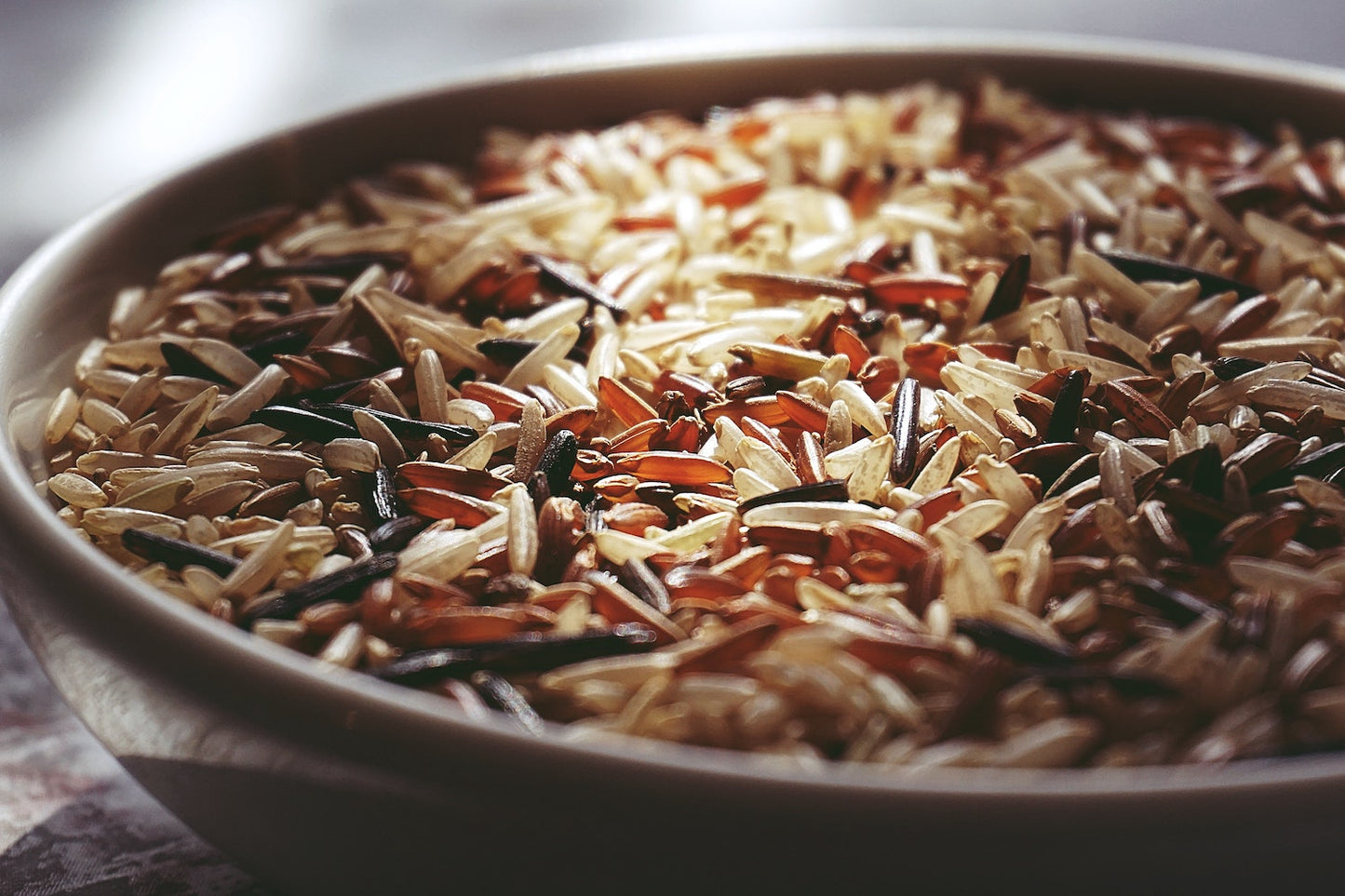
Can You Eat Rice on the Paleo Diet?
The paleo diet has been making waves in the health and wellness world, attracting folks with its back-to-basics approach to eating. It's all about embracing whole, unprocessed foods that our ancestors would have chowed down on and reaping the benefits of such a diet.
But here's the burning question: Can you satisfy your rice cravings while following the paleo path? In this article, we're diving deep into the principles of the paleo diet, taking a closer look at the nutritional value of rice, and figuring out if rice can join the ancestral party on your plate.
What Is the Paleo Diet?
The paleo diet, also known as the caveman or stone age diet, is all about channeling our inner hunter-gatherers. It's inspired by the way our ancestors noshed thousands of years ago.
The idea is simple yet powerful: Eat the foods that our bodies are genetically programmed to handle like champs. That means saying goodbye to grains, legumes, dairy, refined sugars, and processed oils while embracing the whole foods provided by nature.
What Makes a Diet Paleo-Friendly?
A paleo-friendly diet revolves around wholesome goodness. Think lean meats, fish, vibrant fruits, veggies, nuts, and seeds. These are the types of foods that would have been on our ancestors' shopping lists — nature's treasures that pack a nutritional punch.
By steering clear of post-agricultural revolution foods, the paleo diet aims to keep us in touch with our roots (and our waistlines).
What Are the Key Characteristics of the Paleo Diet?
The paleo diet keeps things refreshingly simple, just like life was back in the day. Let's break it down into the key characteristics that make this eating style a true caveman's delight.
- Emphasis on whole foods: Fill your plate with fresh, unprocessed goodies that are bursting with vitamins, minerals, and antioxidants. Say no to those sneaky processed and packaged impostors.
- High protein intake: Load up on high-quality animal proteins, like lean cuts of beef, poultry, wild-caught fish, and eggs. Protein power to fuel your inner caveman!
- Abundance of fruits and vegetables: Fruits and veggies take center stage, bringing a rainbow of fiber, vitamins, and minerals to your plate. These are Mother Nature's gifts to keep you feeling amazing.
- Healthy fat sources: Healthy fats are welcome guests in the paleo party. Avocados, nuts, seeds, and coconut oil provide that satisfying dose of good fats, but remember — moderation is key.
- Elimination of grains, legumes, and dairy: Grains, legumes, and dairy products are excluded from the paleo diet due to their potential to cause inflammation and digestive issues in some individuals.
Why Are Certain Foods Excluded From the Paleo Diet?
The paleo diet isn't afraid to kick certain foods to the curb, and there are solid reasons behind the exclusions.
- Grains and legumes may contain antinutrients, such as lectins and phytates, that can mess with nutrient absorption and cause tummy troubles. No thanks!
- Dairy is a hot topic in the paleo world. It's debated due to its lactose and casein content, which can spell trouble for those with lactose intolerance or dairy sensitivities. So, it's up to you and your tummy to decide if dairy is a pal in your paleo adventure.
- Refined sugars and processed oils? They're a big "no, thank you" in the paleo dictionary. They're known digestive instigators and have a cozy relationship with chronic diseases. You can probably agree that it’s best to steer clear, right?
What Should You Know About Rice?
This grainy superstar holds a special place in the hearts (and bellies) of many cultures worldwide. With its versatility and wide range of types, rice knows how to steal the show on any plate. Get ready to dig into the rice dish of knowledge!
Rice is a superstar in the world of carbohydrates. As a cereal grain, it packs quite a punch when it comes to energizing our bodies. Plus, it's not just empty calories. Rice brings some essential nutrients to the party, although the exact lineup depends on the type of rice you're chowing down on.
What Are the Nutritional Values of Rice?
Now, let's talk about nutrients. Rice is mostly made up of carbohydrates, giving it that calorie-dense reputation. But don't worry — it's not all about the carbs. The exact nutrient content varies depending on factors like the type of rice, cooking methods, and portion sizes.
Brown rice takes the crown for being the more nutritious sibling. It keeps its bran and germ layers intact, which are chock-full of fiber, vitamins, minerals, and antioxidants. White rice, on the other hand, goes through a refining process that removes those layers, resulting in less fiber and fewer nutrients.
The fiber in brown rice can do wonders for your digestion, help you feel satisfied, and support a healthy blood sugar. And let's not forget about the fabulous minerals like magnesium and selenium, as well as those B vitamins that brown rice brings to the table.
But here's the deal: Rice's nutrient profile isn't as flashy as some other paleo all-stars like fruits, veggies, and lean proteins. So if you decide to skip rice on your paleo adventure, don't fret. You won't be missing any essential nutrients.
What Are the Different Types of Rice?
Rice comes in all shapes and sizes, but that doesn't mean it’s all the same. Let's take a tasty tour of some popular rice varieties and discover what sets them apart:
- White rice takes the spotlight as the most famous rice worldwide. It's like the blank canvas of rice, with a mild flavor and fluffy texture when cooked. The outer bran and germ layers may be missing, but it's still a reliable sidekick in the kitchen.
- Brown rice steps up with its nuttier taste, chewier texture, and higher nutrient content. As mentioned earlier, it also holds onto its bran and germ layers, giving it some extra fiber. It's a go-to choice for those seeking a whole-grain option.
- Basmati rice and jasmine rice bring aromatic fireworks to the rice party. Basmati rice rocks long, slender grains and a fragrant aura that adds an extra dose of deliciousness to your meals. Jasmine rice, with its delicate floral aroma, turns any dish into a culinary masterpiece.
- Wild rice is a grainy rebel that isn't actually rice at all — it's a seed! Coming from aquatic grasses, wild rice boasts a distinct flavor, chewy texture, and dark, slender appearance.
Is Rice Compatible With the Paleo Diet?
Ah, the great rice debate! When it comes to the paleo diet, the question of whether rice can join the party sparks some lively discussions. Technically speaking, rice falls outside the paleo boundaries because it's considered a grain.
Remember that the paleo diet aims to embrace the eating habits of our ancestors, which means grains and legumes get the boot. Why? It's all about those pesky antinutrients found in grains that can cause tummy troubles for some folks.
In fact, some people find that ditching grains, including rice, actually improves their digestion and overall well-being. However, it's important to remember that the effects of grains can vary from person to person, so rice might not be such a villain for everyone.
Ultimately, the decision to include or exclude rice from your paleo journey is a personal one. It depends on your health goals, taste buds, and how your body reacts. If you decide to welcome rice into your paleo posse, remember to enjoy it in moderation and focus on nutrient-rich foods that align with the paleo principles.
Is There Any Way You Can Include Rice in the Paleo Diet?
Now, let's dive into the rice-in-paleo territory. While rice isn't typically part of the paleo tradition, some rebels choose to invite it to the party. If you're one of those adventurous souls, here are a few tips to keep in mind:
- Moderation is key: If you give rice the green light, treat it like the cool cousin who drops by occasionally, not the regular guest who overstays their welcome. The paleo diet shines the spotlight on nutrient-packed whole foods, so make sure rice doesn't steal the show.
- Explore other carb alternatives: Expand your horizons and savor the wonders of sweet potatoes, yams, plantains, and squash. These carb sources offer a wider range of nutrients and fiber, fitting more snugly within the paleo family.
- Listen to your body: Everybody is different, and yours might have its own rice-related tale to tell. Pay attention to how rice makes you feel. If it causes digestive distress or other unwanted effects, consider waving goodbye and exploring other options.
What Can Be Used as a Paleo-Friendly Substitute for Rice?
Ready to spice up your paleo plate without rice? No worries! There's a whole world of grain-free options waiting to tantalize your taste buds:
- Cauliflower rice: Get your food processor ready for a culinary adventure! By pulsing cauliflower florets, you can transform them into rice-like granules. Cauliflower rice offers a lower-carb alternative with an extra dose of fiber and nutrients.
- Veggie delights: Don't limit yourself to rice when you can embrace the veggie wonderland. Zucchini noodles (zoodles), spiralized sweet potatoes, and shredded cabbage are all fantastic substitutes that bring flavor and nutrition to your meals.
The Bottom Line
Rice might not be a regular in the paleo diet, but some people choose to include it anyway. If you're one of those adventurous souls, go ahead and enjoy rice in moderation. Just remember, the paleo diet is all about embracing nutrient-dense foods that our ancestors would give a thumbs-up to — think lean meats, fish, fruits, veggies, nuts, and seeds.
At the end of the day, what you put on your plate is your call. It's your health goals, taste buds, and belly that have the final say. If you're unsure about the best path to take, why not seek guidance from a healthcare pro or a registered dietitian? They can help you navigate the paleo waters and ensure your choices align with your well-being and nutritional needs.
Remember, stay true to your health goals, have fun in the kitchen, and keep exploring the wonderful world of paleo possibilities with these fun recipes from Dr. Kellyann. Bon appétit!
Sources:
Are Anti-Nutrients Harmful? | The Nutrition Source | Harvard T.H. Chan School of Public Health
Lactose Intolerance | NCBI Bookshelf
Rice: Importance for Global Nutrition | NCBI Bookshelf
Brown Rice, a Diet Rich in Health Promoting Properties | NCBI Bookshelf
Health Benefits and Adverse Effects of a Gluten-Free Diet in Non–Celiac Disease Patients | PMC







